Growing Sweet Potatoes in a Home Garden
Sweet potatoes mature in 85 to 120 days and they’re extremely frost sensitive. Plant them in full sun three to four weeks after the last frost when the soil has warmed. Make holes 6 inches deep and 12 inches apart. Bury slips up to the top leaves, press the soil down gently but firmly, and water well.
A Comprehensive Guide on How to Plant, Grow and Harvest Sweet Potatoes
Follow these gardening tips to care for these sweet-tasting root vegetables.

If you’ve ever had sweet potato fries, sweet potato kale frittata or any other sweet potato dish, you know just how delicious the root vegetable can be. While they may be sweet, they’re also packed with minerals, fiber and phytonutrients, making them a healthy and delicious addition to your dinner menu. And believe it or not, they’re also incredibly easy to grow on your own! If you’re interested in learning the process, read the below guide on how to grow sweet potatoes. We even share how to plant and harvest them, along with a simple way to grow them in containers.
While any outdoor area works to grow sweet potatoes, note that they flourish best in a sunny vegetable garden and can take 85 to 120 days to fully mature. There are more than 400 varieties of these warm-weather crops, with their flesh classified as being either moist or dry depending on their purple, orange or white color. To help you pick the perfect variety to grow, you’ll find a list of recommended types below. For instance, you can try the centennials, known as America’s most popular sweet potatoes, or even the short-vine vardamans, which are suitable picks for any small gardens. And if you’re new to gardening, you’ll learn that sweet potatoes are tolerant of heat, drought and pests — some of the most common ones like flea beetles and whiteflies are listed below.
Regardless of your reason for growing sweet potatoes indoors or in your backyard — simply to cook a meal or use as ground cover plants, for instance — follow our detailed guide for important tips. You may even find the experience fun and calming compared to purchasing them at your local store.
Recommended Sweet Potato Varieties
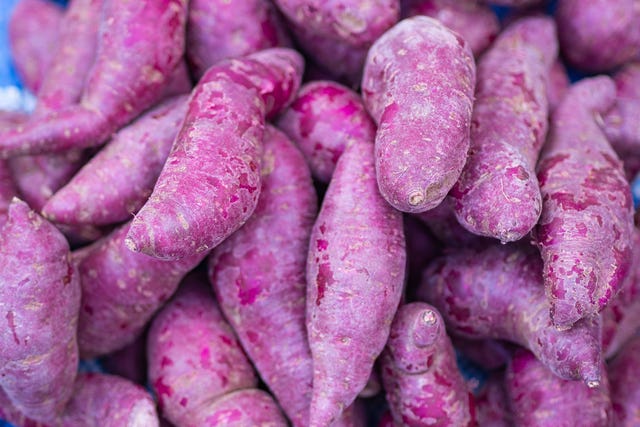
When choosing which sweet potatoes to grow, keep in mind that the fast-growing varieties have orange flesh that becomes moist when cooked, according to The Almanac. However, this shouldn’t stop you from buying others with purple, white or yellow flesh.
- Beauregards: These sweet potatoes have dark-reddish purple skin and take 90 days to mature.
- Bush Porto Ricos: You’ll have to wait for at least 110 days for these copper-colored sweet potatoes to grow. They’re ideal for small gardens and baking.
- Centennials: With their carrot-orange flesh, this widely-used variety takes 100 days to mature. They’re also known as America’s most popular sweet potatoes.
- Georgia Jets: Wait 90 days for this red-skinned variety to grow. They’re fast-growing and have deep orange flesh that’s moist once it’s fully cooked.
- Stokes: Great for savory dishes, stokes have purple skin and rich purple flesh. They take 120 days to mature and are more nutritious in Vitamin C than orange sweet potatoes.
- Vardamans: Since this variety is a bush type, they have short vines that won’t overwhelm the rest of your crops. This makes them great for small gardens. You’ll notice their blue or purple foliage and reddish-orange flesh.
- White Yams: Also called the “White Triumph” for their white skin and white flesh, white yams are one of the oldest sweet potato varieties and take 100 days to mature.
How to Plant Sweet Potatoes
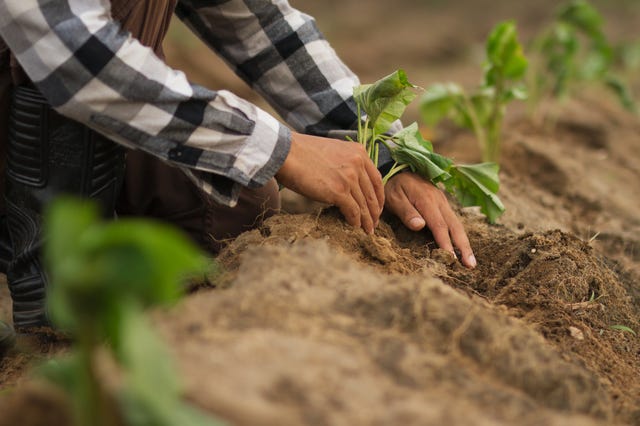
Sweet potatoes will grow in poor soil, but deformed roots may develop in heavy clay or long and stringy, sandy dirt. To create the perfect environment, create long, wide, 10-inch-high ridges spaced 3½ feet apart. A 10-foot row will produce 8 to 10 pounds of potatoes.
Work in plenty of compost, avoiding nitrogen-rich fertilizers that produce lush vines and stunted tubes. In the North, cover the raised rows with black plastic to keep the soil warm and promote strong growth.
It’s best to plant root sprouts, called slips, available at nurseries and mail-order suppliers (store-bought sweet potatoes are often waxed to prevent sprouting). Save a few roots from your crop for planting next year.

About six weeks before it’s time to plant sweet potatoes outdoors in your area (at least three to four weeks after your last spring’s frost), place the roots in a box of moist sand, sawdust or chopped leaves and keep it in a warm spot (75 to 80 degrees). Shoots will sprout, and when they reach 6 to 9 inches long, cut them off the root. Remove and dispose of the bottom inch from each slip, as that portion sometimes harbors disease organisms.
Sweet potatoes mature in 85 to 120 days and they’re extremely frost sensitive. Plant them in full sun three to four weeks after the last frost when the soil has warmed. Make holes 6 inches deep and 12 inches apart. Bury slips up to the top leaves, press the soil down gently but firmly, and water well.
How to Grow Sweet Potatoes
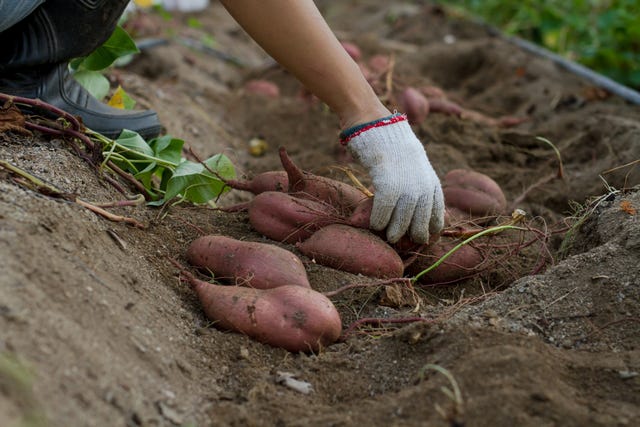
If you’re not using black plastic, mulch the vines two weeks after planting to smother weeds, conserve moisture and keep the soil loose for root development. Occasionally lift longer vines to keep them from rooting at the joints, or they will put their energy into forming many undersized tubers at each rooted area rather than ripening the main crop at the base of the plant. Otherwise, handle plants as little as possible to prevent wounds that are vulnerable to disease spores.
If the weather is dry, provide 1 inch of water once a week until two weeks before harvesting, then let the soil dry out a bit. Don’t overwater, or the plants — which can withstand dry spells better than rainy ones — may rot.
If growing your sweet potatoes in containers, use one large enough to handle their growth (Herbalist Kendra Meador of Epic Gardening recommends a 15 to 20-gallon container like a half whiskey barrel). Pour four inches of soil into the container (Use a mix with compost, sand and high-potassium fertilizer), before placing your slips on top. Secure your slips with three more inches of soil.
Common Pests and Diseases

Southern gardeners are more likely to encounter pest problems than gardeners in Northern areas. Read to learn about how to deal with the most common pests and diseases, and how The Almanac recommends curing them.
- Sweet Potato Weevils: These pests are ¼-inch-long insects with wings, dark blue heads and red-orange bodies. Developing larvae feed on the fleshy roots, while adults generally attack the vines and leaves. They also spread foot rot, which creates enlarging brown to black areas on stems near the soil and at stem ends. Since weevils multiply quickly and prove hard to eliminate, use certified disease-resistant slips and practice a four-year crop rotation. Destroy infected plants and their roots, or place in sealed containers and dispose of them with household trash.
- Black Rot: This results in circular, dark depressions on tubers. Discard infected potatoes, and cure the undamaged roots from the same crop carefully. Don’t confuse this disease with less-serious scurf, which creates small, round and dark spots on tuber surfaces without affecting eating quality.
- Stem Rot: Also known as wilt, this is a fungus that enters plants injured by insects, careless cultivation or wind. Even if this disease doesn’t kill the plants, the harvest will be poor. Minimize the chances of disease by planting only healthy slips. Avoid black and stem rot by planting resistant cultivars. Reduce the incidence of dry rot, which mummifies stored potatoes, by keeping the fleshy roots at 55 to 60 degrees.
- White Rust: This fungus will have chalk-white blisters on the undersides of the leaves. The flowers and stems may also be infected. To rid your sweet potatoes of white rust, destroy the infected plants and try rotating your crops.
- Whiteflies: As the name suggests, these insects are tiny, white and triangular in shape. They’ll leave a sooty substance on your leaves that’ll have them wilted and stunted. Luckily, you can use a vacuum to remove them or spray them with insecticidal soap.
- Flea Beetles: These beetle lookalikes are shiny and can appear black, brown or blue. If you look at the leaves of your potatoes closely, you’ll see them as tiny black dots that leave holes in the leaves. Prevent them from attacking your sweet potatoes using row covers. Mulch heavily to treat and try adding native plants to invite beneficial insects, such as ladybugs. Dill and marigolds are also great companion plants that ward off flea beetles.
How to Harvest Sweet Potatoes
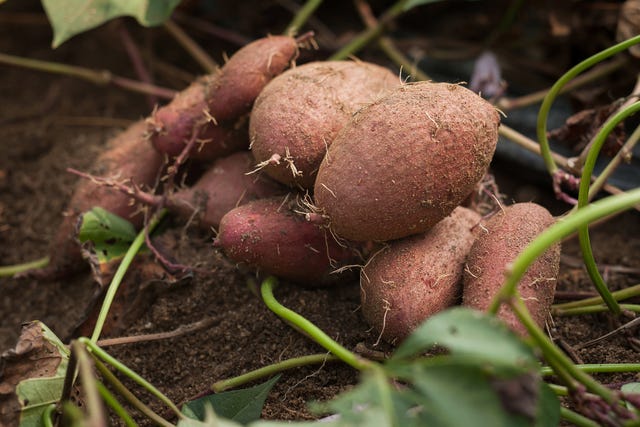
You can harvest as soon as leaves start to yellow, but the longer a crop is left in the ground, the higher the yield and vitamin content. Once frost blackens the vines, however, tubers can quickly rot.
Use a spading fork to dig tubers on a sunny day when the soil is dry. Remember that tubers can grow a foot or more from the plant and that any nicks on their tender skin will encourage spoilage. Dry tubers in the sun for several hours, then move them to a well-ventilated spot and keep them at 85 to 90 degrees for 10 to 15 days. After they are cured, store at around 55 degrees, with a humidity of 75 to 80%. Properly cured and stored sweet potatoes will keep for several months.
More Helpful Pointers
- Are sweet potatoes easy to grow?
Due to their tropical origins, sweet potatoes are easy to grow. The Almanac notes that they’re tolerant of heat and drought, along with being “susceptible to very few pests and diseases.” Just keep in mind, they grow better in warmer areas.
- Can you grow sweet potatoes indoors?
Yes, you can indeed grow sweet potatoes indoors, especially since your home can provide optimal temperatures due to their sensitivity to heat and cold. They’ll thrive in more sunny locations, like by a south-facing window with indirect bright light.
- Can you grow a sweet potato from a whole sweet potato?
Sweet potatoes are grown from slips (a rooted sprout from a mature potato). Simply purchase sweet potatoes from the market and grow your own slips to make more sweet potatoes. One sweet potato can produce around three to five slips, although the varieties differ in their abilities to produce them, notes the Oklahoma State University Extension. They say that a bushel of sweet potatoes (equivalent to 35.2 liters), can produce 2,000 to 2,500 slips in two or three slip harvests.
Growing Sweet Potatoes in a Home Garden
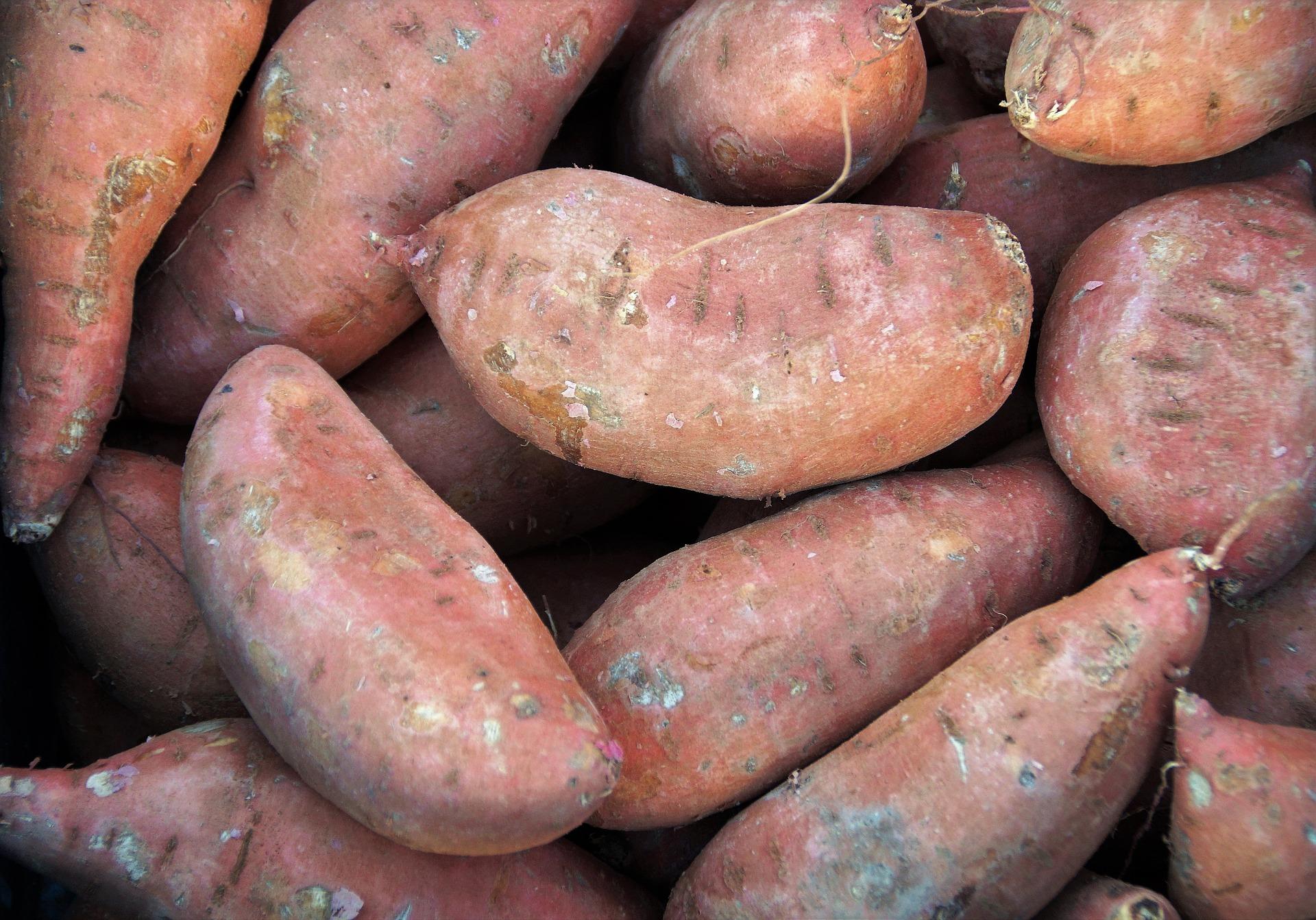
Curing, storage, and preservation of sweet potatoes
- Commercial growers cure their sweet potatoes in special rooms at 85 degrees F. and 80% to 90% relative humidity (RH) for 5 to 10 days. Curing causes the conversion of starch to sugar and helps to heal cuts that could lead to rots. The roots are then stored for 6-8 weeks at 55 to 60 degrees F. to further increase the sugar content.
- Duplicating this process would be very difficult for home gardeners! You can at least partially cure the roots by leaving them on a porch or other covered outdoor location (or in a garage) for a week or so. This works best if you harvest in September when temperature and humidity are still relatively high.
- Spreading the roots out on a screen in a single layer is best.
- If curing outdoors, be sure to protect them from rain and animals.
- Then move the roots to a cool, dry basement, if possible, and store them through the winter in boxes, bins, or baskets, lined with newspaper that allow for good air movement. The sugar content will slowly increase in storage. Roots store best at 55° to 60°F at 85% – 90% RH.
- The roots will shrivel and sprout if temperatures are too high. The roots will usually store successfully even if the one-week curing process is omitted.
